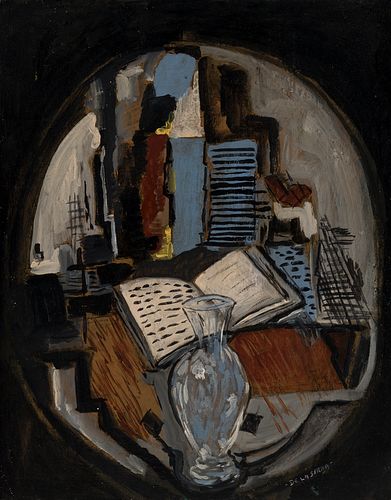ISMAEL GONZÁLEZ DE LA SERNA (Guadix, Granada, 1898 - Paris, 1968). "Still life". Oil on canvas glued to board.
Lot 43
About Seller
Setdart Auction House
Carrer Aragó 346
Barcelona
Spain
Setdart Subastas was born in 2004 and is currently the first online art auction in Spain with solidity, prestige and reliability guaranteed by our more than 60,000 users. Setdart has a young, dynamic and enterprising team ready to successfully manage the purchase and sale of art works through custom...Read more
Estimate:
EUR€3,000 - EUR€4,000
$3,125 - $4,166.67
Absentee vs Live bid
Two ways to bid:
- Leave a max absentee bid and the platform will bid on your behalf up to your maximum bid during the live auction.
- Bid live during the auction and your bids will be submitted real-time to the auctioneer.
Bid Increments
| Price | Bid Increment |
|---|---|
| EUR€0 | EUR€10 |
| EUR€200 | EUR€25 |
| EUR€500 | EUR€50 |
| EUR€1,000 | EUR€100 |
| EUR€3,000 | EUR€200 |
| EUR€5,000 | EUR€500 |
| EUR€10,000 | EUR€1,000 |
| EUR€20,000 | EUR€2,000 |
| EUR€50,000 | EUR€5,000 |
About Auction
By Setdart Auction House
Jul 27, 2021
Set Reminder
2021-07-27 08:00:00
2021-07-27 08:00:00
America/New_York
Bidsquare
Bidsquare : CONTEMPORARY AND ACTUAL ART
https://www.bidsquare.com/auctions/setdart-auction-house/contemporary-and-actual-art-7261
Setdart Auction House sofia@setdart.com
Setdart Auction House sofia@setdart.com
- Lot Description
ISMAEL GONZÁLEZ DE LA SERNA (Guadix, Granada, 1898 - Paris, 1968). "Still life". Oil on canvas glued to board. Attached certificate issued by Sam Bennady. It has slight damage to the frame. Signed in the lower right area. Measures: 50 x 40 cm; 73 x 61 cm (frame). Ismael González de la Serna begins his art studies in Granada and concludes them in Madrid, in the School of Fine Arts of San Fernando. In his early years he developed an eclectic pictorial style, which draws from impressionist, symbolist and modernist sources. One of the first examples of his youthful language can be found in the illustrations he made for his childhood friend Federico García Lorca, in what would be his first book, "Impresiones y paisajes" (1918). That same year, Ismael de la Serna held his first exhibition in Granada, and shortly afterwards he presented his works at the Ateneo de Madrid. In 1921 he moved to Paris in order to broaden his artistic horizons, joining the circles of the School of Paris. Among his Parisian friends was Pablo Picasso, who influenced his work, but he was, above all, the protector of the painter from Granada. De la Serna's style was, in this period, permeable to the influences of the avant-garde, mainly cubism and expressionism, which he worked in a very personal way. Likewise, the initial influence of impressionism was always evident in his work. The year 1927 marked the beginning of a period of strong projection of his work, which began with the solo exhibition that the painter held at the influential Parisian gallery of Paul Guillaume. This exhibition was followed by many others, both in Paris and in Berlin, Brussels, Copenhagen, Granada and Mexico. In 1928 he was commissioned by the director of "Cahiers d'Art", Christian Zervos, to illustrate a special edition of twenty sonnets by Góngora. The key to his recognition is found in his sensual reading of the forms of cubism, based on the relevance of a drawing of sinuous and very decorative lines, combined with strong chromatic contrasts. With a marked spatial sense and without ever abandoning figuration, De la Serna mainly represented still lifes, where he accentuated the sensory side of his painting with metaphorical sensory references, such as music, fruit or open windows. He also worked on landscapes and portraits. After inaugurating with a solo exhibition the activities of the Association of Iberian Artists in Madrid in 1932, the painter undertakes new ways of plastic experimentation that will lead, after the Second World War, to a more schematic and simplified painting, close to contemporary abstract solutions. Ismael de la Serna is represented in the Patio Herreriano Museum in Valladolid, the Reina Sofía Museum in Madrid, the Fine Arts Museums of Granada and Seville, the ARTIUM in Vitoria, the Popular Museum of Contemporary Art in Vilafamés and the Museum of Modern Art in Paris, among many others.
- Shipping Info
-
In-house shipping available. Please inquire at admin@setdart.com.
-
- Buyer's Premium



 EUR
EUR CAD
CAD AUD
AUD GBP
GBP MXN
MXN HKD
HKD CNY
CNY MYR
MYR SEK
SEK SGD
SGD CHF
CHF THB
THB
















